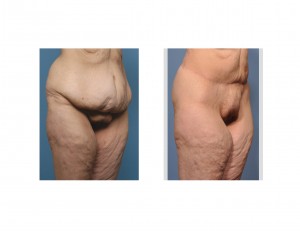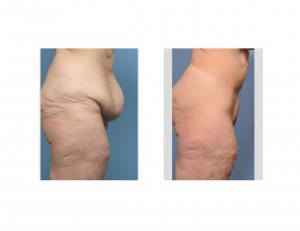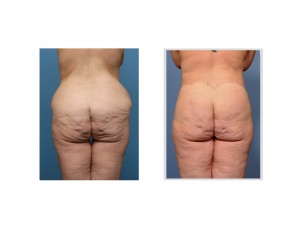Background: Extreme weight loss has a lot of positive medical benefits for the obese patient, from cardiovascular health to an overall lifestyle improvement. The one negative effect from a generalized ‘body deflation’ from the weight loss is the discovery of loose and hanging skin that is seemingly everywhere. While it can occur anywhere from the neck to the ankles, it is always seen in both men and women around the waistline.
While extreme weight loss definitely causes a dramatic change in one”s waistline, one will almost certainly not look like the picture that is often illustrated as seen here. Rather, the negative waistline effects from extreme weight loss can include an overhanging abdominal pannus and hip and buttock sagging. Like the effects of wax dripping off a candle, the skin slides off the upper trunk down over the waistline and into the thighs. Reversal of these effects requires a circumferential approach that removes excess tissue and lifts and tightens around it. This procedure is known as a body lift.
The body lift has become well known as a bariatric plastic surgery technique over the past decade. While it has become popular as a result of the influx of patients from surging numbers of people who have had bariatric surgery, it is actually a much older procedure that dates back decades and is known as a belt lipectomy. The trade-off of a circumferential scar is a small price to pay for the dramatic effects of the procedure.
Case Study: This 42 year-old female had lost 125 lbs after gastric bypass surgery one year previously. Her weight has been stable for the past four months and she had been on a regimented diet and regular exercise program. Her laboratory studies showed stable electrolytes and nutritional levels. She was bothered by an abdominal pannus, bulging hips and hanging buttocks.



Case Highlights:
1) Generalized sagging of the body commonly occurs after extreme weight loss, either from bariatric surgery or diet and exercise-induced..
2) A body lift treats the excess sagging tissues by a waistline circumferential excision.
3) A body lift is a combination tummy tuck, hip lift and upper buttock lift done in a 360 degree horizontal orientation.
Dr. Barry Eppley
Indianapolis, Indiana


